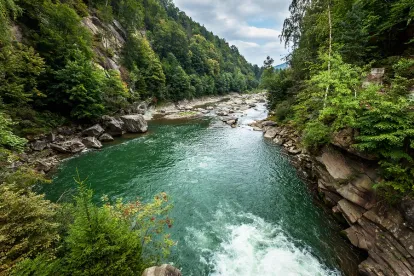Yesterday the Supreme Court of the United States issued its most significant Clean Water Act decision in more than a decade, resolving a split among lower courts over the reach of the Clean Water Act’s “point source” or National Pollutant Discharge Elimination System (NPDES) program. Pollutants travel to bodies of water in many ways: by pipe, ditch, or runoff, for example. The Clean Water Act defines some of those ways of moving pollutants as “point sources”—specifically, pipes, ditches, and similar “discernible, confined and discrete conveyance[s]”—and bans the “addition of any pollutant to navigable waters from any point source” without an NPDES permit. But no similar permitting requirement applies to pollution added from nonpoint sources, which is instead controlled by state and other federal environmental laws.
In County of Maui v. Hawai‘i Wildlife Fund, all nine justices of the Supreme Court concluded that the lower court went too far, and a six-justice majority held that an NPDES permit is instead required “when there is a direct discharge from a point source into navigable waters or when there is the functional equivalent of a direct discharge.” Slip Op. (Maj. Op.) at 15. The decision vacated the lower court’s determination that Hunton Andrews Kurth client County of Maui is required to obtain an NPDES permit and remanded for application of the Supreme Court’s new test.
In the decision reversed by the Supreme Court, the U.S. Court of Appeals for the Ninth Circuit had adopted an expansive reading of the Clean Water Act’s point source program. In 2012, environmental groups brought a citizen suit in federal district court, arguing that four underground injection wells, which dispose of treated wastewater at the County’s Lahaina Wastewater Reclamation Facility, require an NPDES permit in addition to federal and state safe drinking water permits. At that time, the wells had operated for roughly thirty years without any federal or state regulator suggesting that an NPDES permit was required. But the plaintiffs argued that the wells were engaged in point source pollution because injected effluent mixes with groundwater, which flows diffusely over time to the Pacific Ocean. The lower courts agreed. The Ninth Circuit held the County liable because: (1) “the County discharged pollutants from a point source” (i.e., the wells); (2) “pollutants are fairly traceable from the point source to a navigable water such that the discharge is the functional equivalent of a discharge into the navigable water”; and (3) pollutants reach navigable water at “more than de minimis” levels.
Reversing the Ninth Circuit, every member of the Supreme Court agreed with the County’s contention that the Ninth Circuit expanded the reach of the Clean Water Act’s point source program well beyond what Congress intended and into areas left for the States to regulate. Writing for a six-justice majority, Justice Breyer rejected the Ninth Circuit’s requirement of an NPDES permit any time pollutants are “fairly traceable” from a point source to a navigable water. That test “would require a permit in surprising, even bizarre, circumstances.” Slip Op. (Maj. Op.) at 6. Moreover, “the structure of the statute indicates that, as to groundwater pollution and non-point source pollution, Congress intended to leave substantial responsibility and autonomy to the States,” and the Ninth Circuit’s test “could interfere … seriously with States’ traditional regulatory authority” in those areas. Id. Justice Breyer also rejected the environmental groups’ suggested test—that a point source must “proximately cause” the pollutants’ eventual addition to navigable waters—because he “d[id] not see how it significantly narrows the statute beyond the words ‘fairly traceable.’” Id. In two dissenting opinions, Justices Thomas, Alito, and Gorsuch had similar critiques of the Ninth Circuit’s and the environmental groups’ readings of the Clean Water Act. Slip Op. (Thomas, J., dissenting) at 6; Slip Op. (Alito, J., dissenting) at 14.
The Supreme Court splintered, however, over the proper test for determining the necessity of an NPDES permit. In his opinion for the majority, Justice Breyer held that “the statute requires a permit when there is a direct discharge from a point source into navigable waters or when there is the functional equivalent of a direct discharge.” Slip Op. (Maj. Op.) at 15. He explained that “an addition falls within the statutory requirement that it be ‘from any point source’ when a point source directly deposits pollutants into navigable waters, or when the discharge reaches the same result through roughly similar means.” Id. at 15. Thus, “[w]hether pollutants that arrive at navigable waters after traveling through groundwater are ‘from’ a point source depends upon how similar to (or different from) the particular discharge is to a direct discharge.” Id. at 16.
The majority gave some guidance for determining “functional equivalence” or “rough[] similar[ity]” to a direct discharge, but suggested that each case could be different. “Time and distance will be the most important factors in most cases, but not necessarily every case.” Id. Some other factors “that may prove relevant” include “the nature of the material through which the pollutant travels,” “the extent to which the pollutant is diluted or chemically changed as it travels,” “the amount of pollutant entering the navigable waters relative to the amount of the pollutant that leaves the point source,” “the manner by or area in which the pollutant enters the navigable waters,” “the degree to which the pollution (at that point) has maintained its specific identity.” Id. at 16. In addition, “[t]he underlying statutory objectives also provide guidance. Decisions should not create serious risks either of undermining state regulation of groundwater or of creating loopholes that undermine the statute’s basic federal regulatory objectives.” Id. at 17.
The two dissenting opinions criticized the majority for misreading the statutory text and creating significant uncertainty. Joined by Justice Gorsuch, Justice Thomas would limit NPDES permits to direct discharges to navigable waters: “Based on the statutory text and structure, I would hold that a permit is required only when a point source discharges pollutants directly into navigable waters.” Slip Op. (Thomas, J., dissenting) at 1. Writing only for himself, Justice Alito would adopt a nearly identical test as Justice Thomas, but also require a permit for “a discharge from multiple, linked point sources.” Slip Op. (Alito, J., dissenting) at 9 n.5. Both dissents complained that the majority opinion “d[id] little to explain how functionally equivalent an indirect discharge must be to require a permit.” Slip Op. (Thomas, J., dissenting) at 5; see also Slip Op. (Alito, J., dissenting) at 8 (“Regulators will be able to justify whatever result they prefer in a particular case. And judges will be left at sea.”).
This majority decision leaves open many questions but nevertheless provides some important relief and guidance for States, municipalities, businesses, and ordinary homeowners and landowners. The Supreme Court has made clear that an NPDES permit is not needed every time pollution starts from, or passes through, a point source and eventually reaches navigable waters. A permit is not required simply because a pollutant can be traced from a point source to navigable waters, nor is a permit required whenever a point source “proximately causes” pollutants to enter navigable waters. The Court also appears not to have adopted the “direct hydrological connection” test—a test adopted by the Fourth Circuit and previously pressed by EPA. A permit may be required if pollutants are carried by groundwater from a point source to navigable waters, but it is not apparent how often that will be true. It is clear from the opinion that groundwater itself is not a point source.
But as the majority itself acknowledged, it remains to be seen exactly how much farther the “functional equivalence” test will reach beyond direct point source discharges into navigable waters. The majority makes clear that “[w]here a pipe ends a few feet from navigable waters and the pipe emits pollutants that travel those few feet through groundwater (or over the beach), the permitting requirement clearly applies.” Slip Op. (Maj. Op.) at 15-16. But “[i]f the pipe ends 50 miles from navigable waters and the pipe emits pollutants that travel with groundwater, mix with much other material, and end up in navigable waters only many years later, the permitting requirements likely do not apply.” Id. at 16. Time and distance are important, but how much is too much? What limitation is imposed by the requirement that an indirect discharge “reach[] the same result through roughly similar means”? Id. at 15. To what extent will the existence of state regulation matter, given the majority’s instruction that decisions “not create serious risks … of undermining state regulation of groundwater”? Id. at 17.
It is also quite uncertain how potentially regulated entities will be able to determine ahead of time whether they need an NPDES permit. As the majority recognized, its new test may have to develop through “the traditional common-law method, [with lower courts] making decisions that provide examples that in turn lead to ever more refined principles.” Id. EPA, too, may need to provide administrative guidance, whether on a case-by-case basis through permitting or by promulgating general rules. Id. The majority acknowledged the risk this uncertainty poses to individuals and regulated entities, who can be subject to significant civil and criminal penalties. It did not consider these penalties in its statutory interpretation, as the dissents did, but stated its “expect[ation]” that district judges should “calibrate the Act’s penalties” in light of “the complexities inherent to the context of indirect discharges through groundwater.” Id. at 18.
The Maui decision is an important victory for those subject to the Clean Water Act, as it unequivocally rejects the exceedingly broad tests for NPDES permitting adopted by the Ninth Circuit and advanced by the environmental groups. At the same time, the decision raises many questions about the scope of required permitting and creates significant uncertainty for those seeking to determine whether they need to undertake the cost and other burdens of applying for a permit.







 />i
/>i
